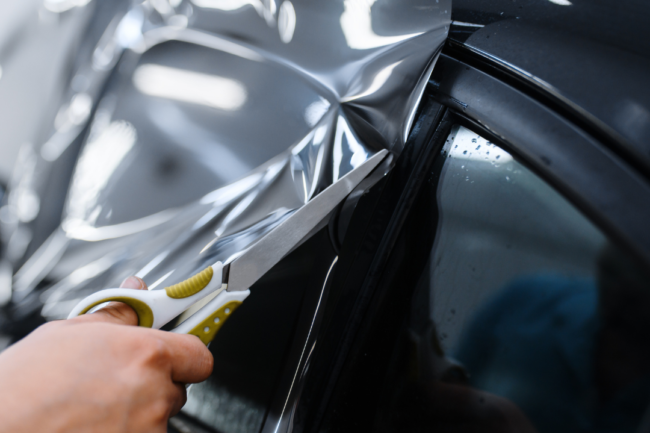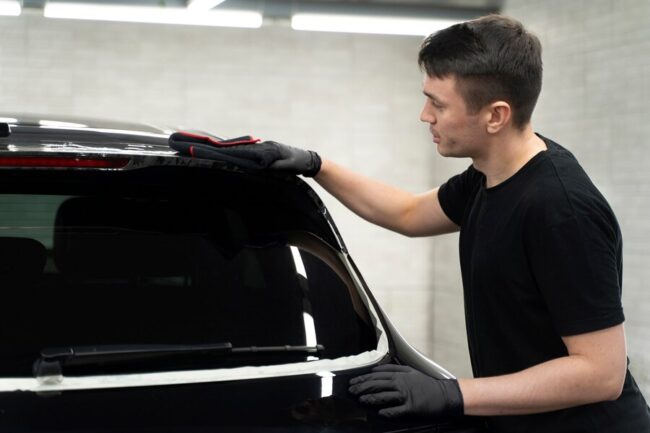In the realm of automotive restoration, enthusiasts and professionals alike are constantly seeking innovative solutions to breathe new life into vintage cars. One such revolutionary approach gaining prominence is the application of ceramic coatings. These coatings, initially developed for aerospace and industrial purposes, have found their way into the automotive world, offering a formidable shield against the ravages of time and the elements. This blog explores the transformative impact of ceramic coatings on restoration projects, specifically focusing on their ability to rejuvenate old cars and bring back their former glory.
Ceramic coatings have emerged as a game-changer in the restoration arena due to their exceptional durability and protective qualities. By forming a resilient and transparent layer on the car’s surface, these coatings act as a shield against environmental contaminants, UV rays, and harsh weather conditions. The result is not merely a cosmetic enhancement; rather, it’s a preservation strategy that safeguards the integrity of vintage vehicles for years to come. As we delve into the intricacies of ceramic coating applications and their role in the restoration process, it becomes evident that this technology is more than just a cosmetic upgrade – it’s a crucial step towards preserving automotive heritage and ensuring the timeless beauty of classic cars persists through the ages.
The Evolution of Ceramic Coatings In Automotive Restoration
The evolution of ceramic coatings in the realm of automotive restoration is a fascinating journey that traverses the boundaries of industrial applications to becoming an indispensable tool for car enthusiasts and restoration professionals. Initially developed for aerospace and industrial purposes, ceramic coatings have undergone significant advancements, adapting to the unique challenges posed by the automotive environment. Over the years, these coatings have transitioned from being exclusive to high-end applications to becoming more accessible, offering a transformative solution for vintage car restoration projects.
Today, the automotive world witnesses the widespread adoption of ceramic coatings due to their exceptional protective properties. As we explore the evolution of these coatings, it becomes evident that their journey mirrors the quest for innovation in preserving the timeless beauty of classic cars. This blog segment aims to unravel the historical trajectory of ceramic coatings, shedding light on their pivotal role in shaping the landscape of automotive restoration.
Unveiling The Science Behind Ceramic Coatings
 Delving into the science behind ceramic coatings reveals a sophisticated amalgamation of cutting-edge technology and chemical ingenuity. At its core, a ceramic coating is a liquid polymer applied to the exterior surfaces of a vehicle, chemically bonding with the factory paint to create a durable and protective layer. This layer, often comprised of silicon dioxide or other ceramic nanoparticles, exhibits remarkable hydrophobic and self-cleaning properties, repelling water, dirt, and contaminants with unparalleled efficacy.
Delving into the science behind ceramic coatings reveals a sophisticated amalgamation of cutting-edge technology and chemical ingenuity. At its core, a ceramic coating is a liquid polymer applied to the exterior surfaces of a vehicle, chemically bonding with the factory paint to create a durable and protective layer. This layer, often comprised of silicon dioxide or other ceramic nanoparticles, exhibits remarkable hydrophobic and self-cleaning properties, repelling water, dirt, and contaminants with unparalleled efficacy.
Understanding the molecular intricacies of ceramic coatings provides insight into their unique ability to resist environmental elements. The nanotechnology employed ensures a microscopic and uniform coverage, creating a robust shield against UV rays, oxidation, and chemical pollutants. This segment of the blog aims to demystify the scientific foundation of ceramic coatings, empowering enthusiasts and professionals alike with a comprehensive understanding of the technology behind the transformative magic they wield in automotive restoration.
Beyond Aesthetics: The Functional Benefits Of Ceramic Coatings
When considering the application of ceramic coatings in automotive restoration, it is essential to recognize that their impact extends far beyond enhancing the visual appeal of a vehicle. Ceramic coatings offer a range of functional benefits that contribute to the longevity and resilience of the vehicle’s exterior. The nano-ceramic particles forming the protective layer create a durable surface that actively guards against scratches, swirl marks, and minor abrasions. This not only preserves the aesthetic integrity but also ensures the structural well-being of the car. Moreover, the hydrophobic nature of ceramic coatings facilitates easy maintenance, as water and contaminants bead off effortlessly, simplifying the cleaning process. The functional advantages of ceramic coatings are diverse and practical, making them a valuable investment for enthusiasts seeking not only a visually stunning restoration but also a vehicle that can withstand the rigors of daily use.
- Scratch Resistance: Forms a robust shield against scratches, swirl marks, and minor abrasions.
- Durability: Creates a resilient surface, contributing to the long-term structural integrity of the vehicle.
- Hydrophobic Properties: Repels water and contaminants, easing maintenance and cleaning efforts.
- UV Protection: Guards against the harmful effects of UV rays, preventing paint oxidation and color fading.
- Chemical Resistance: Shields the vehicle from the corrosive impact of environmental pollutants and contaminants.
- Easy Maintenance: Simplifies cleaning routines, enhancing the overall ease of care for the restored automobile.
Understanding and appreciating these functional benefits underscores the practicality and value that ceramic coatings bring to the restoration process, making them a vital component for both aesthetics and the sustained well-being of the vehicle.
Environmental Hazards: How Ceramic Coatings Shield Against Aging
The relentless assault of environmental hazards poses a constant threat to the longevity and aesthetics of vehicles. Ceramic coatings act as a formidable line of defense, creating a protective barrier against a myriad of detrimental elements. This segment scrutinizes the specific ways in which ceramic coatings shield vehicles from pollutants, UV rays, and harsh weather conditions. By preventing oxidation, color fading, and the corrosive impact of contaminants, these coatings play a pivotal role in mitigating the aging effects that environmental factors inflict on automobiles. As we explore the environmental resilience conferred by ceramic coatings, it becomes evident that their protective capabilities extend far beyond the cosmetic realm, contributing to the sustained well-being of restored vehicles.
Long-Term Investment: Ceramic Coatings And The Future Of Restoration
Investing in ceramic coatings for automotive restoration transcends the immediate aesthetic enhancements, evolving into a strategic and forward-thinking approach for enthusiasts and professionals alike. Beyond the visual allure, ceramic coatings become a crucial component in preserving the value and longevity of restored vehicles, shaping the future of automotive restoration. The enduring protective layer provided by ceramic coatings acts as a shield against the ravages of time, environmental elements, and daily wear. This long-term investment perspective extends beyond the restoration phase, safeguarding the vehicle’s value over the years.
 Value Retention: Ceramic coatings contribute to maintaining the resale value of restored vehicles.
Value Retention: Ceramic coatings contribute to maintaining the resale value of restored vehicles.- Durability: The protective layer ensures prolonged resistance to scratches, oxidation, and environmental contaminants.
- Reduced Maintenance Costs: Minimizes the need for frequent detailing and repairs, saving on long-term maintenance expenses.
- Preservation of Originality: Helps retain the original factory paint, preserving the authenticity of vintage and classic cars.
- UV Resistance: Guards against color fading and degradation caused by prolonged exposure to UV rays.
- Enhanced Appearance Over Time: Ensures a consistently glossy and well-maintained appearance, even as the years pass.
Embracing ceramic coatings as a long-term investment in the restoration process signifies a commitment to the sustained quality and value of the vehicle. As enthusiasts look to the future, the integration of ceramic coatings becomes a pivotal element in the evolving landscape of automotive restoration, ensuring that the beauty and integrity of restored vehicles endure for generations to come.
DIY vs. Professional Application: Making the Right Choice
As the popularity of ceramic coatings grows, individuals embarking on restoration projects face the crucial decision of whether to undertake the application themselves or enlist professional assistance. This section provides an in-depth analysis of the pros and cons associated with DIY application versus seeking the expertise of professionals. From considerations of skill and equipment requirements to potential pitfalls and the level of protection achieved, this exploration guides readers in making an informed choice that aligns with their restoration goals. Whether opting for a hands-on approach or relying on professionals, understanding the implications of each decision ensures that the benefits of ceramic coatings are maximized in the context of the restoration journey.
Challenges and Considerations: Navigating Restoration With Ceramic Coatings
Navigating the realm of automotive restoration with ceramic coatings involves addressing specific challenges and considerations to ensure a successful and satisfying outcome. While these coatings offer transformative benefits, enthusiasts and professionals must be mindful of potential hurdles throughout the restoration journey:
- Skill and Expertise: DIY application may pose challenges for individuals without prior experience, as precision and technique play a significant role.
- Environmental Factors: Weather conditions can impact the application process, necessitating careful planning to avoid issues like uneven curing or contamination.
- Product Quality: Choosing a high-quality ceramic coating product is vital; lower-grade options may not deliver the promised durability and protection.
- Budgetary Constraints: Assessing the cost of ceramic coatings and associated tools versus potential long-term benefits is essential for effective budget management.
- Professional Assistance: Enlisting the expertise of professionals ensures a meticulous application but comes with additional costs.
- Type of Vehicle: The size, material, and condition of the vehicle influence the amount of coating required and the complexity of the application process.
Navigating these challenges and considerations demands a thoughtful approach, balancing the desire for a restored vehicle with practical considerations to achieve the best possible results in both aesthetics and protection.
In conclusion, the rise of ceramic coatings in automotive restoration has ushered in a new era of preservation and enhancement for classic cars. From understanding the science behind these coatings to exploring real-world success stories, enthusiasts and professionals have uncovered a powerful tool in revitalizing automotive heritage. As you embark on your restoration journey, navigating challenges and considering key factors will be essential. For expert guidance and application services, contact Quality Auto Glass & Tint at 4500 Salida Boulevard, Suite D-E, Modesto, CA, 95368, or reach out at (209) 900-8269 or Support@qualityautoglasstint.com. Transform your vehicle with care and precision, Monday to Saturday from 9 am to 5 pm. Elevate your automotive restoration experience with Quality Auto Glass & Tint.




